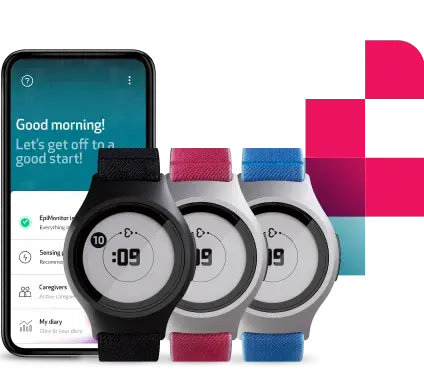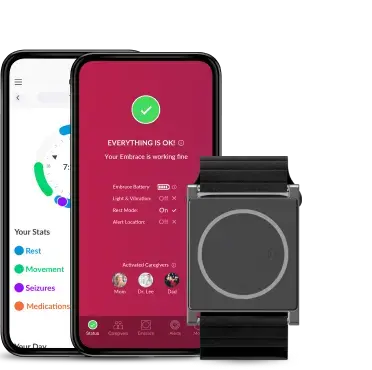Staying safe this summer with epilepsy
Summertime, and the livin’s easy, as they say. We’re guessing your plans this summer might include everything from exploring new cities, barbeques to spending the entire day at the beach. While you’re soaking in the sunshine, and enjoying the best of what the season has to offer, it’s important to still be mindful of some safety precautions specific for epilepsy. We rounded up the top tips from experts on the subject such as the Epilepsy Foundation, and compiled them all in one place for you, here!
Swimming
You should first check with your doctor if it’s okay to go swimming with your seizure types. If they advise that it’s fine, never swim alone (1). Always have a buddy (even if you’re wearing Embrace). And they should be strong enough to keep your head above water if a seizure occurs. Also, make sure that someone around, whether it’s your friend or a lifeguard, knows how to help in case of a seizure (1). With regards to Embrace, you can wear it in the pool for up to 30 minutes, just don’t go deeper than 3 feet/1 meter. We ask that you avoid saltwater, as it may damage the hardware. It’s also important to note that Bluetooth connectivity will not work if Embrace is submerged in water, and therefore alerts cannot be sent to caregivers.
Curious to learn more about how Embrace works? Watch our animated video.
Stay hydrated
The summer bliss of warmer temperatures and spending more time in the sun can unfortunately leave us dehydrated due to increased perspiration. Getting enough fluids helps the overall functioning of the body, and eliminates bacteria from your bladder (2). For some, dehydration may result in more seizures, so it’s important to quench your thirst (3). Adults should try to drink around 8 cups of water daily, while children should aim for 6-8 (3). If you have trouble remembering, creating a “hydrate” reminder on your phone could help make sure you get the daily recommended amount.
Travel
Traveling and having epilepsy shouldn’t create any problems, so long as a few things are taken into consideration beforehand. If possible, we recommend having friend or family member with you that knows how to assist you during a seizure as they can also help in navigating unfamiliar situations, and make sure that you get the care and support you need.
If you’re taking medication for your seizures, remember to bring enough to last the duration of the trip, plus several days (in case of a flight delay). Continue to take it at your regular intervals even if there’s a change in time zones and routine (4). A simple way to stick to your schedule is to set an alarm on your phone. If you are flying and checking luggage, bring half of the medication with you on your flight, and the other half in your checked luggage. This gives you some cushion in case bags are lost and have to be tracked down.
If your trip requires a flight, you should first check with your doctor that it’s okay. He or she may need to consider how changing time zones, high altitude, possible loss of sleep could impact your seizures (5). If you’re cleared to fly, ask your doctor for a letter describing your seizures that also outlines your seizure response plan in case complications arise (5).
If you haven’t spoken with your doctor about Embrace yet, we recently designed a dedicated page for doctors on our website that could help start the conversation.
If you’re an Embrace user, you’ll be instructed to put your phone in Airplane mode, which means that Bluetooth will be disabled, and Embrace will not be able to send alerts. You should also make sure that your final destination will have a reliable internet connection, otherwise Embrace won’t be able to send alerts. Nearly every hotel offers free Wi-Fi, but it’s hard to tell beforehand if the connection is reliable. This is why we recommend to check with your carrier if your data plan will work abroad. It might be worth opting for a special travel plan to ensure a faster and more reliable connection.
As your daily routine is likely to vary while you’re on vacation, we recommend using the Mate App for Embrace users, to keep track of any changes in seizure frequency, rest and physical activity.
See how we recently redesigned Mate to make your data easier to understand and more meaningful: Meet the new Mate: our AI-powered seizure diary gets a new look
Relax and enjoy
A little extra planning is all it takes to enjoy the season and stay safe. Thinking about the challenges and coming up with ways to address them should make you feel more secure and less stressed, which is very important as stress is a common seizure trigger (6). Long lines, unforeseen events, and large crowds can make the actual trip a bit stressful, so it’s important to stay calm even when things don’t go exactly as planned.
Sometimes a little music is all we need to calm our nerves. Some studies show that music can do much more than that. Read more: Could Music Help People with Epilepsy?
Disclaimer: Embrace is a prescription only device that is indicated for use as an adjunct to seizure monitoring of adults and children ages 6 and up in home or healthcare facilities during periods of rest.
Words worth reading
Sources
- https://www.epilepsy.com/learn/managing-your-epilepsy/summer-camp/water-safety
- https://www.health.harvard.edu/staying-healthy/the-importance-of-staying-hydrated
- https://www.epilepsy.com/article/2017/7/charlie-foundation-reminds-you-hydrate-well-during-these-summer-months
- https://www.ddssafety.net/health/seizures/travel-planning-people-seizures
- https://www.epilepsy.com/learn/managing-your-epilepsy/adapting-plans-travel/types-travel-and-vacations
- https://www.epilepsy.com/learn/triggers-seizures/stress-and-epilepsy
We do not guarantee that EpiMonitor will detect every single seizure and deliver alerts accordingly. It is not meant to substitute your current seizure monitoring practices, but rather to serve as a supplement in expediting first-response time.



